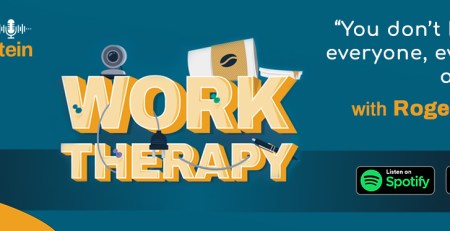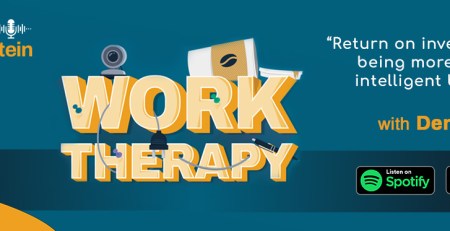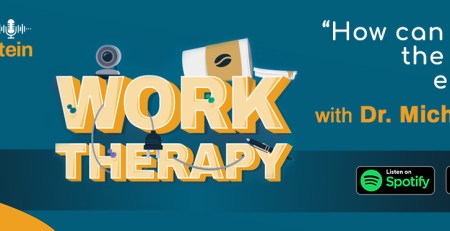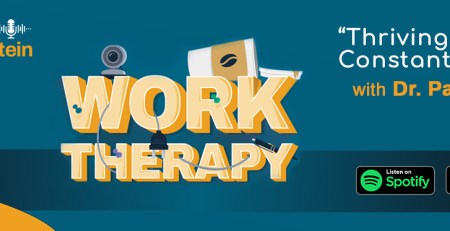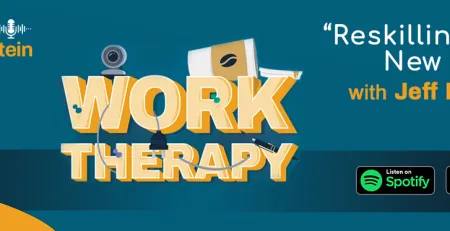Work Therapy: Help! Is AI Taking My Job?
In this week’s episode of Work Therapy with Dr. Steven Stein, we chat with Frincy Clement, an award-winning Artificial Intelligence leader and the Canadian Ambassador for Women in Artificial Intelligence, a global community of women AI practitioners.
We discuss the mark AI will inevitably leave on our careers and how much we should really be concerned about the possibility of job loss. Plus, is ChatGPT a helpful, democratized tool, or is it just telling us what we want to hear?
DR. STEIN: We’re all thinking about it. So, let’s talk about AI because we have found ourselves in the wild west of another new technology that many people worry could soon put them out of work. So, it’s true that in 10 to 15 years or maybe even sooner, your job as it functions right now might not even exist, but that doesn’t mean your career won’t. I’m Dr. Steven Stein. I’m a clinical psychologist and founder of MHS, a leading developer of innovative scientific assessments within the talent development space and beyond. I’m here to tell you that work sucks sometimes. It does. I can admit it, but it doesn’t have to. In Work Therapy, we speak with experts from diverse backgrounds helping us wade through some of the most common issues people have on the job. We learn how to go beyond just surviving at work and learn how to start thriving because if work sucks, how can we fix it?
DR. STEIN: On today’s episode, “Help, is AI taking my job?” I talk to Frincy Clement about the mark AI will leave on all of our careers. Will a highly productive robot be the reason countless people lose their jobs? And is Chat GPT a helpful democratized tool or is it just telling us what we want to hear? Now, Frincy, I understand you currently work as a data scientist, but you also lead the Canadian Chapter of Women in AI. Tell me a little bit about how you got into the area of artificial intelligence.
FRINCY: Thank you, Steve. It is great to be part of this program. Thank you for inviting me. I’m not originally in the data science field. I started my career working in the field of business initially, and when I wanted to do more beyond what the business roles can offer me, I understand that AI or data science could be a great career to have, and in that way, I transitioned my career halfway through my professional journey. And as I was looking through people and communities who can help me achieve my professional goals, I could not find enough women out there or there was not much visibility for women, and that’s when I stumbled upon Women in AI and I started getting involved in the community and being part of the Canadian Chapter, which helped me increase the community from scratch to a thousand members today.
DR. STEIN: Great. So how do you feel, some people get scared when they hear about AI, it’s going to take away their jobs or affect them in some way at some new thing. What do you tell people about jobs and how AI may affect that?
FRINCY: It is a fact that AI is going to replace or change the jobs that we will see today. So, if you look at historically how the jobs changed, for example, 50 years back, the type of jobs that was there it’s not exactly the same as it is today. Similarly, AI is adding another disruption in the technology field where we are going to see those changes faster than we thought. So, to those who are struggling to adapt to technology, I would like to say that we are living in a fast-paced technological world where tools, systems, processes are changing constantly. And depending on which industry you are in, there can be a faster or slower adoption in using AI as part of your average jobs.
FRINCY: So first and foremost, the reality is that you need to accept the fact that it is happening, and the next step would be to get to know these tools, resources out there where you can learn from. Your organization might give you some courses or free programs, or you can ask your peers and your team to get help, “How do I learn these new technologies?” So, you have to be proactive in order to learn those, and if you’re self-motivated, there are many, many online resources out there where you can learn from. And once you start learning something, you can start experimenting or you can play around with those technologies.
DR. STEIN: So, what you’re suggesting is that they start off by just playing around with the technology and getting familiar with it?
FRINCY: So, in order to play around with the technology, you need to first understand what the technology is about. So, if I give my example on how or what I did when I transitioned my career, I initially started looking at some online courses to understand what this AI is about, so at least some basic foundational knowledge. And then my goal was to go into a technical role. So, I went a little bit more deeper into AI and understood how can I build an algorithm, how can I solve a use case? But if your job is content creation or if your job is graphic designing or something of that sort, then you know you should know how to use these tools to make it beneficial for you. So, for example, once you’re aware that, “Okay, I’m a graphic designer, there are many tools outside available there, which can help me increase my productivity,” understanding these tools will enable you to use these tools in the future when your organization is actually releasing it.
DR. STEIN: Okay. Well, that gets right to the theme of our show, which is called Work Therapy, When Work Sucks, How Can We Fix It? And right at the nub of that is that people are afraid to do that, to make that step and go forward with the new technology. So, what would you say to that scared person who hears about Chat GPT for example, and says, “Oh my God, this is going to take away my job. What do I do here?” What can they do using that as an example? They boot up Chat GPT and how do they start? Where do they go?
FRINCY: So, if you just want to experience Chat GPT, you can go to their website and try to use and understand how it does. On the other side, we also need to understand that Chat GPT is not a hundred percent accurate. There’s a lot of risks and privacy issues associated with Chat GPT, which is being currently investigated and all of that. A lot of these tech companies are now bringing in their own large language models into market, and a lot of products are getting enabled with that.
DR. STEIN: So, suppose I work in customer service, or I work in sales, and I look at one of these tools and maybe they’re developing one of these tools to actually replace me in customer service. What am I going to do about that? I mean, do I really want that tool to come in and answer questions even better than I can, and maybe even sense how the customer’s feeling and the customer’s getting angry because they didn’t get what they want? Do you think that we’re going that far, that we’re going to be able to generate that?
FRINCY: At this point, in the next two or three months, I don’t think it is going to happen. But the way that AI has evolved, nobody can predict how fast and how far we can go. Because I remember one of the very senior AI leaders, they thought maybe another hundred years, another thousand years, it might take us for AI to be here as we see today. So, nobody can predict, but it is not entirely impossible for the roles like customer service can be replaced with AI. There is already a lot of research done. There’s already tools available out there in order to do that where they can read your face, your features, how the emotions are changing on your face, how the emotions are changing in your tone, your eye movements. So, everything can be tracked and can be analyzed, and we can put it in a text or an audio and say that, “Okay, this is what the person is feeling,” this is your customer service chatbot.
FRINCY: But at the end of the day, not everything can be automated and there is always a need for human intervention. So, any use case you take, there needs to be validations done. We need to know whether everything checks off from a requirements perspective to an accuracy perspective to the way the tool is supposed to behave for the intent and purposes. So, I always believe even with all the advancements of technology, there needs to be a human in the loop. If you take the human out, then it is going to be disastrous. And I certainly believe that AI, even though it is disrupting the jobs, it can act as a great enabler. So, the role of a customer service agent can change or evolve into something else where we leave the tasks that a machine can do the best and focus on other tasks where humans can do the best.
DR. STEIN: Okay, Frincy. So, I’m feeling a little more relaxed. I’m not going to be replaced right away. There’s still room for me to work. There’s still things I can do. That’s great news. So again, it’s going to be sort of elevating my position or using my position in a different way. Technology is my friend, right? Artificial intelligence should be my friend. It should help me in doing what I’m doing and doing it better.
FRINCY: Yeah. I do want to add one more thing, Steve. So right now, with these emerging advancements, there is no regulation in place. Being afraid is actually justified because the way the content is it just being spread around on the internet, there is no way for us to identify whether this is fake or real. So, for example, Google has a partnership that they’re doing with Adobe to generate this artificial content, whether this image or video.
FRINCY: But what they will do is they will track this artificially generated content with a watermark or metadata that says it is an AI generated content. So, organizations are also adopting ways so that we can responsibly use technologies like AI, while they’re also scared that this is going to affect humanity in the future. So similarly, in order to enforce that government or international organizations, we need to have regulations in place in order to regulate AI for the responsible use of AI so that we have guardrails and guidelines in place on how we use AI and for what purposes we use AI, so that we can always strike a balance between being afraid versus being productive or making the best out of AI.
DR. STEIN: It sounds like we’re going through the wild west here in terms of how people are using AI. Good, so there will be guardrails, there will be some protections to ensure the reliability I guess, and validity of what we’re getting. I recently was doing some work where I was using Chat GPT to help look at some of the newest research in emotional intelligence in a specific area, and it came back with some really beautiful results, and I started zeroing down to validate the results. I asked what the studies were and so on, and I went to one of the studies and I kept trying to find it and after a lot of searching, it didn’t exist, it made it up. It was a totally false study that sounded wonderful. So, in a way it sounds like they were trying to please me by telling me what I wanted to hear and just inventing a research study that didn’t exist. So how are the guardrails, how are we going to prevent that kind of thing from happening, or I guess, we call it keeping Chat GPT honest?
FRINCY: I mean, these are my own opinions. Maybe we were too fast to make a tool like Chat GPT in the public without ensuring that the data that they have used for training Chat GPT is good enough, is it responsible enough? And without even measuring how the tool will be used. But now that it is available, people understand that AI is coming. So now we have to make sure, or the policy makers, the government officials who controls things in a country or on international scale, they have to be aware about all of these, and I’ve seen that even U.S. and Canada, there were a lot of emergency meetings that was called to ensure that they start putting guardrails.
DR. STEIN: Okay. So, I guess I’m a little bit scared into the direction this might go, so let’s flip the coin on the other side. On the positive side, where do you see this technology taking us? What are some of the things that maybe we haven’t even thought about, the avenues we could go with this technology?
FRINCY: So, the way that AI has enabled us in everyday life as we see it today, whether it is the face recognition in your iPhone or the product recommendation in Amazon, or what’s next in your Netflix, it has got integrated without even us noticing. So, there are fields where AI is entered with much caution, like medical field or the law where it is affecting humans the most. I can also see that AI will get more involved in diagnosis of medical issues or more like an assistant to doctor, where machines can tell you maybe more accurately or more certainly with the help of a doctor that such and such issue exists, so that is actually increasing the productivity of a physician.
FRINCY: So similarly, again with this, once we have more guardrails in place and validations done, it can also help with a lot of your day-to-day tasks, so it enables us to do things faster and be more productive. I am certain that the way things are moving, there will be new revolutions or new breakthroughs in the coming years that will be beyond our imagination, that some things that we once thought was impossible could also happen in our near future.
DR. STEIN: So Frincy, tell me a little bit about your view on how companies can really facilitate this. What can they do to help make this change?
FRINCY: Yeah, definitely. So, whenever companies are deciding to roll out any new technologies or any new processes, I would strongly think that they should plan ahead in order to avoid resistance or disconnect from the employees in terms of, “Oh, I need to learn a new technology now.” So if the companies are able to adapt or adopt processes or proper planning in place, they will be able to avoid these kinds of resistance, able to help employees get enabled on this new technology.
DR. STEIN: So, I guess, in the long-term, AI is our friend, right? It will be our friend and help us along. Alright, I want to circle back to where we started something at the beginning, which is women in AI. Do you have a sense at this point, I guess, what the percentage of women are that is working in this area, this part of the industry? And secondly, what is it that you can do to increase the participation of women in this area?
FRINCY: Definitely. So globally, what we see is like 18 to 20, 22 percentage of women in the overall workforce in AI. And even though we have come so far, it is still very low compared to the evolution of AI or how far we have come. So, a lot of things that we have done as a community is to educate, mentor and connect women. So how do we educate at different age groups? How do you influence and encourage girls to take Math and Computer Science or AI? It all starts from there.
FRINCY: Now, once you are growing and you are choosing the career path that you want to go in your undergrad or your Master’s, how do we help them understand, “You’re not alone, you have a lot of people who you can rely on,” so education is key. Second one is making conscious choices where we keep diversity as part of our framework in order to achieve or bring more women in the professions. It takes a village; I would say it’s not just a community like us or people or individuals. It takes a village, 18 to 20% to 40, 50 in the next five, 10 years.
DR. STEIN: It’s great, Frincy, really great to hear the work you’re doing and how you’re managing all this. Is there anything about the topic or the subject that we’ve left out that you’d want to add to or things you’d want to say?
FRINCY: So, what I wanted to add is AI is not just replacing you. AI is your friend. AI is your enabler, and with proper guardrails in place, AI can achieve greater things for you in your life.
DR. STEIN: That’s great, Frincy. All right, thank you very much. This has been really great. I enjoyed this great talk.
FRINCY: Thank you for having me, Steven.
DR. STEIN: After speaking with Frincy, I have a lot to consider about AI. I’m impressed by her work in making the AI industry more inclusive, and although I’m still slightly nervous about what the future of AI holds, I’m also pretty excited about it. With AI, we can be more creative, turning ideas into action faster. While some of us are focused intensely on the future of our jobs, this change in tech also gives us a chance to just think about what we truly want our jobs to be. My first tip for you today is to consider things that may have seemed out of reach before but could become part of your future role. What tasks or skills do you envision yourself enjoying and excelling at in that future? Tip two is to find some way you can begin to get ahead of that tech curve and educate yourself.
DR. STEIN: Learn about using AI in your job or somewhere else in your life. Instead of allowing AI to get ahead of you, use it as a tool to build yourself up, incorporate this new technology into your unique skillset and let it be a way that you make yourself indispensable. And finally, tip three is for leaders. Job security is a top concern for employees and a lack of clarity can lead to low morale. Ensure your team understands that any new tools in the workplace are meant to help them, not replace them. Show them that you respect their knowledge and experience by bringing them into the discussions about how to incorporate new technologies and do it sooner rather than later. They may even have some great ideas. I’m Dr. Steven Stein, and I look forward to our next episode of Work Therapy, let’s make work suck less together.
Have any feedback about this episode or want to learn more about MHS? Reach out to us at [email protected]

